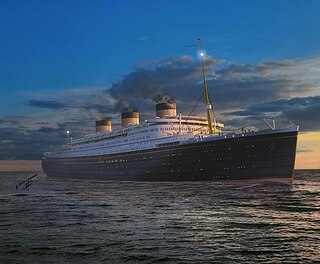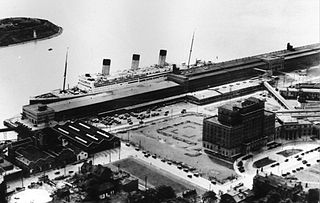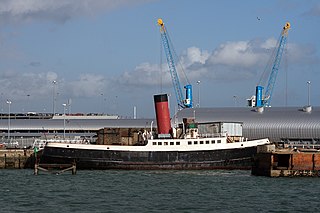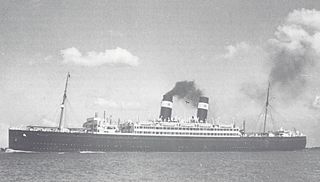
Kaiser Wilhelm der Grosse was a German transatlantic ocean liner named after Wilhelm I, German Emperor, the first monarch of the (second) German Empire.

A steamship, often referred to as a steamer, is a type of steam powered vessel, typically ocean-faring and seaworthy, that is propelled by one or more steam engines that typically move (turn) propellers or paddlewheels. The first steamships came into practical usage during the early 1800s; however, there were exceptions that came before. Steamships usually use the prefix designations of "PS" for paddle steamer or "SS" for screw steamer. As paddle steamers became less common, "SS" is assumed by many to stand for "steam ship". Ships powered by internal combustion engines use a prefix such as "MV" for motor vessel, so it is not correct to use "SS" for most modern vessels.
Transatlantic crossings are passages of passengers and cargo across the Atlantic Ocean between Europe or Africa and the Americas. The majority of passenger traffic is across the North Atlantic between Western Europe and North America. Centuries after the dwindling of sporadic Viking trade with Markland, a regular and lasting transatlantic trade route was established in 1566 with the Spanish West Indies fleets, following the Voyages of Christopher Columbus.

An ocean liner is a passenger ship primarily used as a form of transportation across seas or oceans. Liners may also carry cargo or mail, and may sometimes be used for other purposes.

A passenger ship is a merchant ship whose primary function is to carry passengers on the sea. The category does not include cargo vessels which have accommodations for limited numbers of passengers, such as the ubiquitous twelve-passenger freighters once common on the seas in which the transport of passengers is secondary to the carriage of freight. The type does however include many classes of ships designed to transport substantial numbers of passengers as well as freight. Indeed, until recently virtually all ocean liners were able to transport mail, package freight and express, and other cargo in addition to passenger luggage, and were equipped with cargo holds and derricks, kingposts, or other cargo-handling gear for that purpose. Only in more recent ocean liners and in virtually all cruise ships has this cargo capacity been eliminated.

A troopship is a ship used to carry soldiers, either in peacetime or wartime. Operationally, standard troopships – often drafted from commercial shipping fleets – cannot land troops directly on shore, typically loading and unloading at a seaport or onto smaller vessels, either tenders or barges.

RMS Oceanic was a transatlantic ocean liner built for the White Star Line. She sailed on her maiden voyage on 6 September 1899 and was the largest ship in the world until 1901. At the outbreak of World War I she was converted to an armed merchant cruiser. On 8 August 1914 she was commissioned into Royal Navy service.

The RMMV Oceanic was the planned name of an unfinished ocean liner that was partially built by Harland and Wolff for the White Star Line. The ship was to have been the first 1,000-foot (300 m)-long ocean liner. It was intended to be the largest ocean liner for the White Star Line, thus it would have been larger than the earlier White Star giants, Olympic, Titanic, Britannic, and Majestic.
Ocean Breeze may refer to:

Pier 21 was an ocean liner terminal and immigration shed from 1928 to 1971 in Halifax, Nova Scotia, Canada. Over one million immigrants came to Canada through Pier 21 and it is the last surviving seaport immigration facility in Canada. The facility is often compared to the landmark American immigration gateway Ellis Island. The former immigration facility is now occupied by the Canadian Museum of Immigration, the Nova Scotia College of Art and Design as well as various retail and studio tenants.

The fifth SS Rotterdam, also known as "The Grande Dame", is a former ocean liner and cruise ship, and has been a hotel ship in Rotterdam, the Netherlands, since 2010. She was launched by Queen Juliana of the Netherlands in a gala ceremony on 13 September 1958, and was completed the following summer. The Rotterdam was the last great Dutch "ship of state", employing the finest artisans from the Netherlands in her construction and fitting out process. Her career spanned forty-one years. She sailed from 1959 until her final retirement in September 2000.
Bremen is a city in northwestern Germany.

A four-funnel liner is an ocean liner with four funnels. The Great Eastern, launched 40 years prior to any other comparable ship in 1858, was the only ocean liner to have five funnels. Kaiser Wilhelm der Grosse, launched in 1897, was the first ocean liner to have four funnels and was one of the first of the golden era of ocean liners that became prominent in the 20th century.

The Athenic-class ocean liners were a three ship class of ocean liners built by the Harland & Wolff shipyard for the White Star Line in the early 20th century.
The French Atlantic Affair is a novel by Ernest Lehman which was published in 1977. A 3-part TV miniseries based on the book was produced and broadcast in 1979.

SS Princess Adelaide was a passenger vessel in the coastal service fleet of the Canadian Pacific Railway (CPR) during the first half of the 20th century.

TSS T/T Calshot is a tug tender built in 1929 by John I Thornycroft & Co, and completed in 1930 for the Red Funnel Line. Upon the tugboat's completion, she was put into service tendering the various liners that stopped either in the Solent or Southampton Water which saved them the time and expense of docking just to take up or set down a few passengers. She was also used to augment the excursion fleet. Calshot remained in service with Red Funnel from 1930-1964.

SS Pittsburgh was a transatlantic ocean liner. It was built by Harland and Wolff in Belfast for the American Line. Initial construction began in 1913, but was delayed by World War I. The ship was completed in 1920, and made its first voyage in 1922 for the White Star Line. In 1925, as Pennland, it commenced operations for the Red Star Line. The ship was refitted as a troopship for the Allies in World War II. The ship was bombed April 25, 1941 in the Gulf of Athens and sank.















